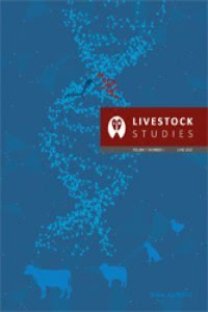KONYA HAYVANCILIK MERKEZ ARAŞTIRMA ENSTİTÜSÜNDEKİ ESMER IRK SIĞIRLARIN DÖLVERİMİ PERFORMANSI
Bu çalışmada, 1976 ve 1985 yıllarında Enstitüde bulunan 637 inek ve 27 boğaya ait bilgiler incelenmiştir. Ele alınan dölverimi özellikleri ve bu özelliklere ait değerler, İsviçre Esmeri, Alman Esmeri, Amerikan Esmeri, Karacabey Esmeri ve genel ortalama olarak sırasıyla şöyledir; İlk sıfat yaşı, 27.50, 26.98, 25.25, 26.53 ve 26.30 ay, ilk buzağılama yaşı 37.61, 37.82, 35.60, 37.53 ve 36.75 ay, gebelik oranı % 73.8, 70.3, 73.1, 72.3 ve 72.1, anöstrüs oranı %10.6, 11.8, 13.4, 7.1 ve 11.4 , yavru atma, erken doğum ve ölü doğum oranları taplama % 2.4, 1.8, 5.9, 3.0 ve 3.0, ikizlik oranı % 2.9, 2.4, 0.7, 2.9 ve 2.3, her gebelik için gerekli tohumlama sayısı 1.45, 1.44, 1.35, 1.68 ve 1.44, buzağılama aralığı 12.56, 12.74, 12.79, 12.69 ve 12.66 ay, doğum sonrası ilk tohumlama aralığı 80.3, 79.7, 83.2, 84.0 ve 80.9 gün, gebelik süresi 287.2, 287.7, 288.9, 289.5 ve 287.9 gün, servis periyodu 104.1, 126.1, 123.9, 121.7 ve 115.7 gün, ilk – son tohumlama aralığı 58.7, 40.0, 38.8, 64.6 ve 49.0 gün bulunmuştur. Genotip grupları dölverimi özelliklerine göre değerlendirildiğinde, en iyi performansı Amerikan Esmer grubunun gösterdiği ve bunu sırasıyla İsviçre, Alman ve Karacabey Esmer gruplarının takip ettiği görülmüştür. Boğalara ait dölverimi özellikleri incelendiğinde, boğalar arasında önemli farklılıkların bulunduğu dikkati çekmiştir. Bu nedenle dölverimi özelliklerinde yapılacak seleksiyonlarda boğa faktörüne özel bir önem verilmesi gerektiği kanısına varılmıştır. Dölverimi özelliklerinin doğum yaşına ve doğum sayısına göre incelenmesi sonucu, en iyi performansı 4 yaşında veya 3. doğumunu yapan ineklerin gösterdiği 4 yaş veya 3. doğuma kadar artan dölverimi performansının daha sonraki yaş veya doğumlarda düştüğü görülmüştür.
(Fertility perforrnance in Brown Swiss Herd at Konya Livestock Research Center)
The purpose of this study was to investigate and compare the fertility performances of the genetic groups of Brown Swiss cattle which are at Konya Livestock Research Center. Data of 637 cows and 27 bulls within the period from 1976 through 1985 were analysed. The results of the fertility traits were given as Swiss Brown Swiss, German Brown Swiss, American Brown Swiss, Karacabey Brown Swiss and. overall herd respectively. The ages at first insemination were 27.50, 26.98, 25.25, 26.53, and 26.30 months, the ages at first calving were 37.61, 37.82, 35.60, 37.53, and 36.75 months, the conception rates were 73.8, 70.3, 73.1, 72.3 and 72.1 %, anoestrus rates were 1 0.6, 11.8,13.4, 7.1 and 11.4 %, the percentages of abortions, prematurebirths and stillbirths were 2.4, 1.8, 5.9, 3.0 an 3.0 %, twinning rates were 2.9, 2.4, 0.7, 2.9 and 2.3 %, the number of inseminations per conception were 1.45, 1.44, 1.35, 1.68 and 1.44, calving intervals were 12.56, 12.74, 12.79, 12.69 and 12.66 monts, gestation lengths were 287.2, 287.7, 288.9, 289.5 and 287.9 days, service periods were 104.1, 126.1, 123.9, 121.7 and 115.7 days, the intervals from parturition to first insemination were 80.3, 79.7, 83.2, 84.0 and 80.9 days, the intervals from first insemination to conception were 58.7, 40.0, 38.8, 646 and 49.0 days. The evaluation of some fertility traits of Brown Swiss genetic groups indicated that American groups showed the best reproductive performance among the all groups. The differences among reproductive performances of bulls were found significant. For this reason, the consideration of rnale fertility in the selection programmes would result an increase in reproductiw performance. The evaluation of fertility traits according to the age of cows and the parities showed that 4-year-olds and third parıty cows had hıgher reproductıve performance than the others. The reproductive performance increased until 4-yearolds and the third parity, and decreased with increasing age and parity.
